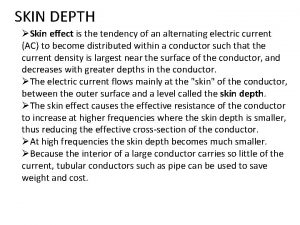SKIN DEPTH Skin effect is the tendency of




- Slides: 4

SKIN DEPTH ØSkin effect is the tendency of an alternating electric current (AC) to become distributed within a conductor such that the current density is largest near the surface of the conductor, and decreases with greater depths in the conductor. ØThe electric current flows mainly at the "skin" of the conductor, between the outer surface and a level called the skin depth. ØThe skin effect causes the effective resistance of the conductor to increase at higher frequencies where the skin depth is smaller, thus reducing the effective cross-section of the conductor. ØAt high frequencies the skin depth becomes much smaller. ØBecause the interior of a large conductor carries so little of the current, tubular conductors such as pipe can be used to save weight and cost.

Distribution of current flow in a cylindrical conductor, shown in cross section. For alternating current, most (63%) of the electric current flows between the surface and the skin depth, δ, which depends on the frequency of the current and the electrical and magnetic properties of the conductor.

ØThe charge carriers constituting that current, usually electrons, are driven by an electric field due to the source of electrical energy. ØAn alternating current in a conductor produces an alternating magnetic field in and around the conductor. When the intensity of current in a conductor changes, the magnetic field also changes. ØThe change in the magnetic field, in turn, creates an electric field which opposes the change in current intensity (back emf is more at centre). ØRegardless of the driving force, the current density is found to be greatest at the conductor's surface, with a reduced magnitude deeper in the conductor. That decline in current density is known as the skin effect and the skin depth is a measure of the depth at which the current density falls to 1/e (or 37%) of its value near the surface. ØOver 98% of the current will flow within a layer 4 times the skin depth from the surface. The skin effect has practical consequences in the analysis and design of radio-frequency and microwave circuits, transmission lines (or waveguides), and antennas. ØAlthough the term "skin effect" is most often associated with applications involving transmission of electric currents.








